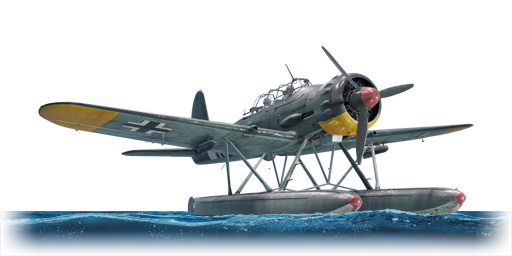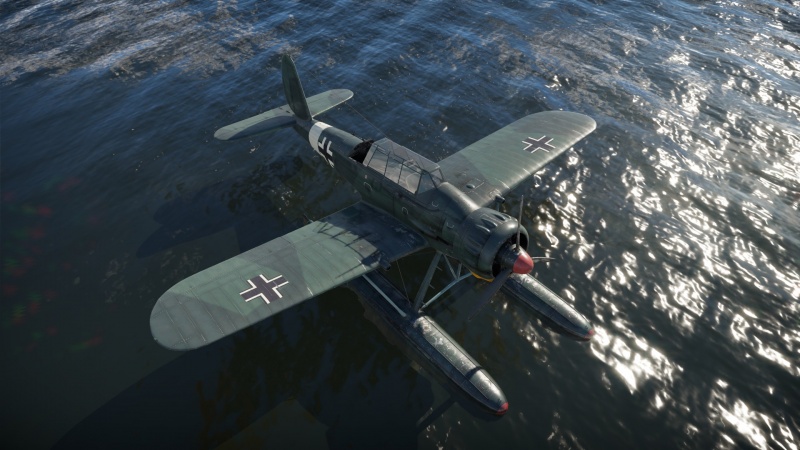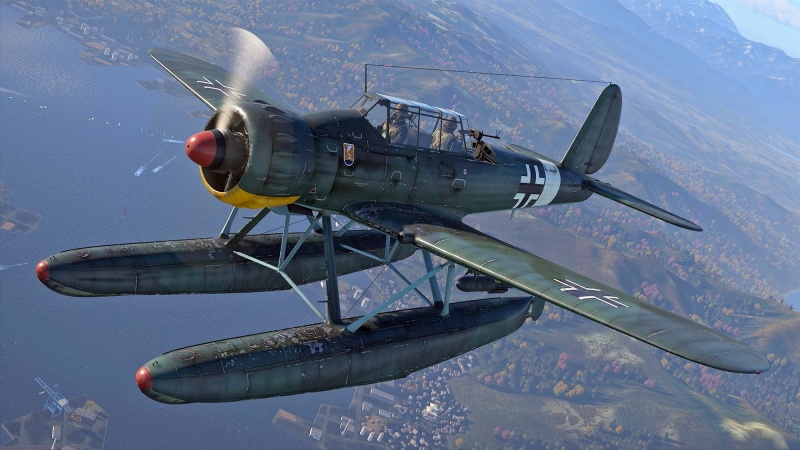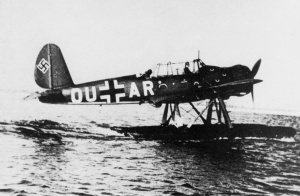Difference between revisions of "Ar 196 A-3"
(Undo revision 130413 by U104491753 (talk) Plagiarism from https://www.skytamer.com/Arado_Ar.196A.html) |
(Edits) |
||
| (15 intermediate revisions by 6 users not shown) | |||
| Line 1: | Line 1: | ||
| + | {{About | ||
| + | | about = gift German bomber '''{{PAGENAME}}''' | ||
| + | | usage = the Swedish version | ||
| + | | link = Ar 196 A-5 (Sweden) | ||
| + | }} | ||
{{Specs-Card | {{Specs-Card | ||
|code=arado-196a-3 | |code=arado-196a-3 | ||
| Line 6: | Line 11: | ||
== Description == | == Description == | ||
<!-- ''In the description, the first part should be about the history of and the creation and combat usage of the aircraft, as well as its key features. In the second part, tell the reader about the aircraft in the game. Insert a screenshot of the vehicle, so that if the novice player does not remember the vehicle by name, he will immediately understand what kind of vehicle the article is talking about.'' --> | <!-- ''In the description, the first part should be about the history of and the creation and combat usage of the aircraft, as well as its key features. In the second part, tell the reader about the aircraft in the game. Insert a screenshot of the vehicle, so that if the novice player does not remember the vehicle by name, he will immediately understand what kind of vehicle the article is talking about.'' --> | ||
| − | + | In 1936, the Kriegsmarine sought for a replacement to their existing biplane ship-launched floatplanes. The German Air Ministry helped with the aircraft selection and sent orders out for companies to send their contenders. Arado submitted their Ar 196 design alongside Focke-Wulf, Dornier, and Gota-Vagon-Fabrik in Autumn 1936. Among the competition, the Arado design won out and entered production in November 1938. Aside from its ship-launched variant, a land-based variant was also designed and entered production in 1939 as the A-2 that saw addition of weapons and the capability to carry ordnance. By the end of 1940, the '''Ar 196 A-3''' began production for use in coastal patrol roles. Several samples also found its way to Germany-aligned or conquered countries like Bulgaria, Romania, Finland, and Norway. Additionally, a portion of the machines fell into the hands of the USSR as trophies and were used in aviation border units until the late 1950s, with their BMW 132K engines being replaced by domestic ASH-62IR engines. | |
| − | + | Introduced during [[Update "Starfighters"]] as a reward for the [[wt:en/news/6808-special-operation-s-u-m-m-e-r-2020-en|2020 Operation S.U.M.M.E.R.]] event, the Ar 196 A-3 has since been made available in the game as a ship-launched reconnaissance aircraft in naval battles. Considered as one of the best naval scouts in history, nicknamed "the eyes of the Kriegsmarine"! The Ar 196 A-3 has every chance of becoming the new king of the sandpit: it is armed with a pair of 20 mm MG FF cannons and an MG 17 rifle-calibre machine gun, it can also carry 2 x 50 kg bombs under its wings. The Ar 196 A-3 also has a defensive turret with a 7.92 mm machine gun, which is quite good in the initial ranks. And of course, just like the other hydroplanes in the game, the Ar 196 A-3 is able to capture control points in naval battles. <ref>[[wt:en/news/6809/current|Devblog]]</ref> | |
| − | '''Ships that carry the Ar 196 A-3''' | + | '''Ships that carry the Ar 196 A-3 as a ship-launched reconnaissance aircraft''' |
| − | * | + | * {{Specs-Link|germ_cruiser_admiral_graf_spee}} |
| − | * | + | * {{Specs-Link|germ_cruiser_admiral_hipper}} |
| − | * | + | * {{Specs-Link|germ_cruiser_karlsruhe}} |
| − | * | + | * {{Specs-Link|germ_cruiser_prinz_eugen}} |
| + | * {{Specs-Link|germ_battleship_scharnhorst}} | ||
== General info == | == General info == | ||
| Line 33: | Line 39: | ||
|- | |- | ||
! Stock | ! Stock | ||
| − | | | + | | 300 || 292 || rowspan="2" | {{Specs|ceiling}} || 22.2 || 23.2 || 4.1 || 4.1 || rowspan="2" | 450 |
|- | |- | ||
! Upgraded | ! Upgraded | ||
| Line 152: | Line 158: | ||
'''Cons:''' | '''Cons:''' | ||
| − | * Pontoons destroyed very easily, which contain the | + | * Pontoons destroyed very easily, which contain the fuel tanks |
* Low ammo count for cannon | * Low ammo count for cannon | ||
* Slow, poor energy retention | * Slow, poor energy retention | ||
| Line 188: | Line 194: | ||
* ''reference to the series of the aircraft;'' | * ''reference to the series of the aircraft;'' | ||
* ''links to approximate analogues of other nations and research trees.'' --> | * ''links to approximate analogues of other nations and research trees.'' --> | ||
| + | |||
| + | ;Related development | ||
| + | * [[Ar 196 A-5 (Sweden)]] | ||
;Aircraft of comparable role, configuration and era | ;Aircraft of comparable role, configuration and era | ||
| − | + | * [[OS2U-3]] | |
| − | * | + | * [[F1M2]] |
| − | * | + | * [[Late 298D]] |
| − | * | + | * [[S17BS]] |
== External links == | == External links == | ||
Latest revision as of 20:40, 4 July 2024
| This page is about the gift German bomber Ar 196 A-3. For the Swedish version, see Ar 196 A-5 (Sweden). |
Contents
Description
In 1936, the Kriegsmarine sought for a replacement to their existing biplane ship-launched floatplanes. The German Air Ministry helped with the aircraft selection and sent orders out for companies to send their contenders. Arado submitted their Ar 196 design alongside Focke-Wulf, Dornier, and Gota-Vagon-Fabrik in Autumn 1936. Among the competition, the Arado design won out and entered production in November 1938. Aside from its ship-launched variant, a land-based variant was also designed and entered production in 1939 as the A-2 that saw addition of weapons and the capability to carry ordnance. By the end of 1940, the Ar 196 A-3 began production for use in coastal patrol roles. Several samples also found its way to Germany-aligned or conquered countries like Bulgaria, Romania, Finland, and Norway. Additionally, a portion of the machines fell into the hands of the USSR as trophies and were used in aviation border units until the late 1950s, with their BMW 132K engines being replaced by domestic ASH-62IR engines.
Introduced during Update "Starfighters" as a reward for the 2020 Operation S.U.M.M.E.R. event, the Ar 196 A-3 has since been made available in the game as a ship-launched reconnaissance aircraft in naval battles. Considered as one of the best naval scouts in history, nicknamed "the eyes of the Kriegsmarine"! The Ar 196 A-3 has every chance of becoming the new king of the sandpit: it is armed with a pair of 20 mm MG FF cannons and an MG 17 rifle-calibre machine gun, it can also carry 2 x 50 kg bombs under its wings. The Ar 196 A-3 also has a defensive turret with a 7.92 mm machine gun, which is quite good in the initial ranks. And of course, just like the other hydroplanes in the game, the Ar 196 A-3 is able to capture control points in naval battles. [1]
Ships that carry the Ar 196 A-3 as a ship-launched reconnaissance aircraft
General info
Flight performance
| Characteristics | Max Speed (km/h at 2,000 m) |
Max altitude (metres) |
Turn time (seconds) |
Rate of climb (metres/second) |
Take-off run (metres) | |||
|---|---|---|---|---|---|---|---|---|
| AB | RB | AB | RB | AB | RB | |||
| Stock | 300 | 292 | 22.2 | 23.2 | 4.1 | 4.1 | 450 | |
| Upgraded | 344 | 320 | 19.9 | 21.0 | 11.2 | 7.0 | ||
Details
| Features | ||||
|---|---|---|---|---|
| Combat flaps | Take-off flaps | Landing flaps | Air brakes | Arrestor gear |
| ✓ | ✓ | ✓ | X | X |
| Limits | ||||||
|---|---|---|---|---|---|---|
| Wings (km/h) | Gear (km/h) | Flaps (km/h) | Max Static G | |||
| Combat | Take-off | Landing | + | - | ||
| 498 | 469 | 320 | ~9 | ~8 | ||
| Optimal velocities (km/h) | |||
|---|---|---|---|
| Ailerons | Rudder | Elevators | Radiator |
| < 270 | < 280 | < 250 | > 324 |
Survivability and armour
- No armour protection
- Self-sealing fuel tanks in the floats
Modifications and economy
Armaments
Offensive armament
The Ar 196 A-3 is armed with:
- 2 x 20 mm MG FF cannons, wing-mounted (60 rpg = 120 total)
- 1 x 7.92 mm MG 17 machine gun, fuselage-mounted (500 rpg)
For different roles, different belts should be used. For air battles, Air Targets should be loaded, because it contains the most HE rounds. The 7.92 mm can be loaded with Universal or Stealth. However, if your aim is less than stellar, Tracers will help you aim. In naval, however, Stealth should be loaded for the MG FFs. Contrary their name, Stealth belts are actually not at all stealthy as every round fired can be seen. They can be used instead for attacking ships, and hitting components. The 7.92 mm can be loaded with Tracers or Universal.
Suspended armament
The Ar 196 A-3 can be outfitted with the following ordnance:
- 2 x 50 kg SC50JA bombs (100 kg total)
Defensive armament
The Ar 196 A-3 is defended by:
- 1 x 7.92 mm MG 15 machine gun, dorsal turret (525 rpg)
Usage in battles
The Arado Ar 196 excels at destroying light ground targets, and with its twin MG FF armament it can head-on virtually any aircraft at the BR and win. Compound that with the fact that there are many inexperienced players at the BR who will head-on any target they meet, and it will be easy to accrue kills. However, the 196 loses energy very easily due to the 2 massive floats strapped to the bottom of the fuselage. The 196 usually goes out in a "blaze of glory" early on into the match, due to the playstyle revolving around killing ground targets.
Manual Engine Control
| MEC elements | ||||||
|---|---|---|---|---|---|---|
| Mixer | Pitch | Radiator | Supercharger | Turbocharger | ||
| Oil | Water | Type | ||||
| Controllable | Controllable Not auto controlled |
Controllable Not auto controlled |
Controllable Not auto controlled |
Separate | Not controllable 1 gear |
Not controllable |
Pros and cons
Pros:
- Powerful cannon armament
- Good MG for rear turret
- Can be very useful for capping points in Naval
- Good cockpit visibility
- Very good low speed handling
Cons:
- Pontoons destroyed very easily, which contain the fuel tanks
- Low ammo count for cannon
- Slow, poor energy retention
- Low bomb load
History
The Ar 196 was a German shipborne floatplane reconnaissance aircraft that equipped the majority of the Kriegsmarine's ships during the Second World War. Designed as a replacement to the obsolete He 60, the Ar 196 started entering service in the late 1930s to equip German capital ships such as ships of the Deutschland, Scharnhorst and Bismarck classes. The planes saw their first service in late 1939 as scouts for the pocket battleship Graf Spee, and later distinguished themselves by capturing the British submarine HMS Seal. Many Ar 196 floatplanes were captured by Allied forces, and several aircraft survive in museums to this day.[2]
Design and development
In the early 1930s, the primary German floatplane fighter was the Heinkel He 60, an underpowered biplane design that soon became obsolete. Thus, the Air Ministry (RLM) decided to pursue the development of a new naval floatplane fighter. Heinkel submitted the He 114, a sesquiplane, while several other firms submitted similar biplanes designs. However, the Arado firm decided to create an unconventional monoplane design, which proved to have significantly better performance than its competitors.[2] Thus, four prototypes were ordered; more conservative elements of the RLM decided to order the Focke-Wulf designed Fw 62, a more conventional biplane, but the order was cancelled when the Ar 196 proved to be well adapted for its role.[2]
The Ar 196 was of monoplane construction, and featured a BMW engine producing just under 1,000 hp. It was flown by a crew of two - a pilot and a navigator, who doubled as the rear gunner. Armament consisted of a formidable two 20 mm MG/FF cannons and a single 7.92 mm machine gun firing forward, and a single 7.92 mm machine gun on a flexible mounting in the rear cockpit. The first pre-production Ar 196 model was delivered in late 1938, and following shakedown tests, the first production aircraft were delivered in June of 1939.[2]
Operational History
The Ar 196 first saw battle service in late 1939, when two Ar 196s were loaded aboard the pocket battleship Graf Spee. They served as the medium range reconnaissance aircraft and were responsible for locating the majority of the Spee's victims. Another notable action took place in mid-1940, when land-based Arado 196s captured a British submarine, the HMS Seal.[2] After the Seal struck one of its own mines during a minelaying operation, patrolling Ar 196s managed to damage the submarine by bombs and gunfire to prevent her from submerging. An Arado landed beside the submarine, whose commander decided to surrender.[2]
Production of the Ar 196 was slow, having been shifted between multiple aircraft producers. Nevertheless, the Ar 196 served as the main catapult floatplane for Kriegsmarine capital ships until the end of the war. Production had been terminated in 1944 due to the relative obsolescence of the Ar 196 against the modern allied fighters it frequently encountered over the German coast.[2] Several Ar 196s survived the war, including two floatplanes confiscated with the German heavy cruiser Prinz Eugen. Two Ar 196s survive, one at a Bulgarian museum and the other in storage at the National Air and Space Museum in the United States.[2]
Media
- Skins
- Images
See also
- Related development
- Aircraft of comparable role, configuration and era
External links
References
- Citations
- Bibliography
- National Air and Space Museum. (2020). Arado Ar 196 A-5. Retrieved November 23, 2020, from https://airandspace.si.edu/collection-objects/arado-ar-196-a-5/nasm_A19610128000
| Arado Aircraft Corporation (Arado Flugzeugwerke) | |
|---|---|
| Bombers | Ar 196 A-3 |
| Jet Bombers | Ar 234 B-2 · Ar 234 C-3 |
| Export | ▄Ar 196 A-5 |
| Germany bombers | |
|---|---|
| Arado | Ar 196 A-3 |
| Blohm & Voss | BV 138 C-1 · BV 238 |
| Dornier | Do 17 E-1 · Do 17 Z-2 · Do 217 E-2 · Do 217 E-4 · Do 217 K-1 · Do 217 M-1 |
| Focke-Wulf | Fw 189 A-1 · Fw 200 C-1 |
| Henschel | Hs 123 A-1 |
| Heinkel | He 111 H-3 · He 111 H-6 · He 111 H-16 · He 115 C-1 · He 177 A-3 · He 177 A-5 |
| Junkers | Ju 87 B-2 · Ju 87 R-2 · Ju 87 R-2 Libya · Ju 87 D-3 · Ju 87 D-5 · Ju 88 A-1 · Ju 88 A-4 · Ju 188 A-2 · Ju 288 C |
| Messerschmitt | Me 264 |
| Savoia-Marchetti | ▀S.M.79 serie 1 · ▀S.M.79 B · ▀S.M.79 serie 4 · ▀S.M.79 serie 8 |
| ▀S.M.79 AS · ▀S.M.79 bis/N · ▀S.M.79 bis/T.M | |
| Trophies | ▀Wellington Mk Ic |
| Germany premium aircraft | |
|---|---|
| Fighters | He 51 B-2/H · BV 155 B-1 |
| He 112 | He 112 B-1/U2 · He 112 B-2/U2 |
| Bf 109 | Flegel's Bf 109 A · Bf 109 E-7/U2 · Bf 109 G-2 |
| Fw 190 | Fw 190 A-5/U14 · Fw 190 C · Fw 190 D-13 |
| Captured | ▀Marcolin's C.R.42 CN · ▀Hawk H-75A-2 · ▀Yak-1B · ▀La-5FN · ▀P-47D-16-RE · ▀P-47D · ▀Tempest Mk V |
| Twin-engine fighters | Bf 109 Z-1 · Ju 388 J · Ta 154 A-1 |
| Jet fighters | ◄Sea Hawk Mk.100 · ◄G.91 R/4 · FFA P-16 · ◄MiG-21 SPS-K · ◊MiG-21 "Lazur-M" |
| Strike aircraft | Hs 129 B-2 (Romania) · ▀IL-2 (1942) · Bf 110 C-6 · Do 335 B-2 · He 219 A-7 · ◄Tornado IDS WTD61 · ◄Su-22M4 WTD61 |
| Bombers | Ar 196 A-3 · BV 238 · Fw 189 A-1 · He 177 A-3 · Ju 87 R-2 Libya · Ju 288 C · ▀Wellington Mk Ic |
| Ship-launched reconnaissance aircraft | |
|---|---|
| USA | O3U-1 · OS2U-1* · SOC-1 |
| Germany | Ar 196 A-3* |
| USSR | KOR-1 |
| Britain | Osprey Mk IV · Walrus Mk.I |
| Japan | E7K2 · E8N2 · E13A1 · F1M2* |
| Italy | Ro.43 |
| France | GL.832HY · Loire 130С |
| *Available standalone in tech tree | |








